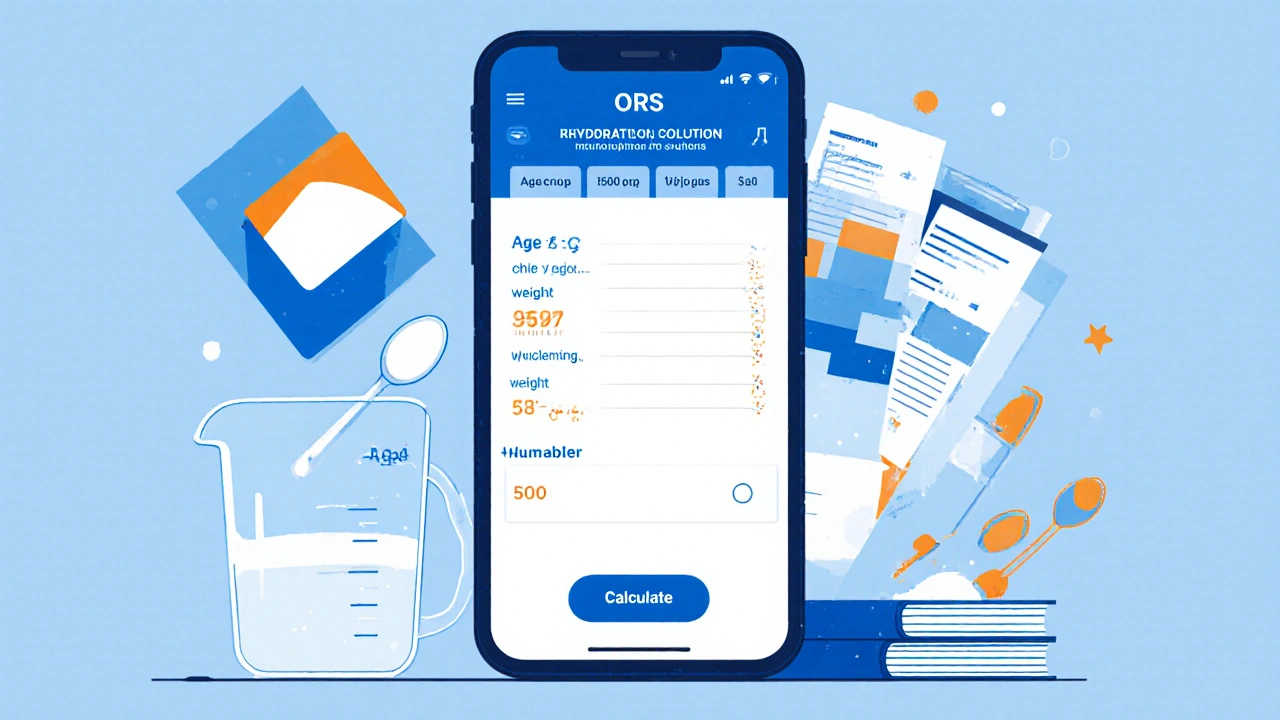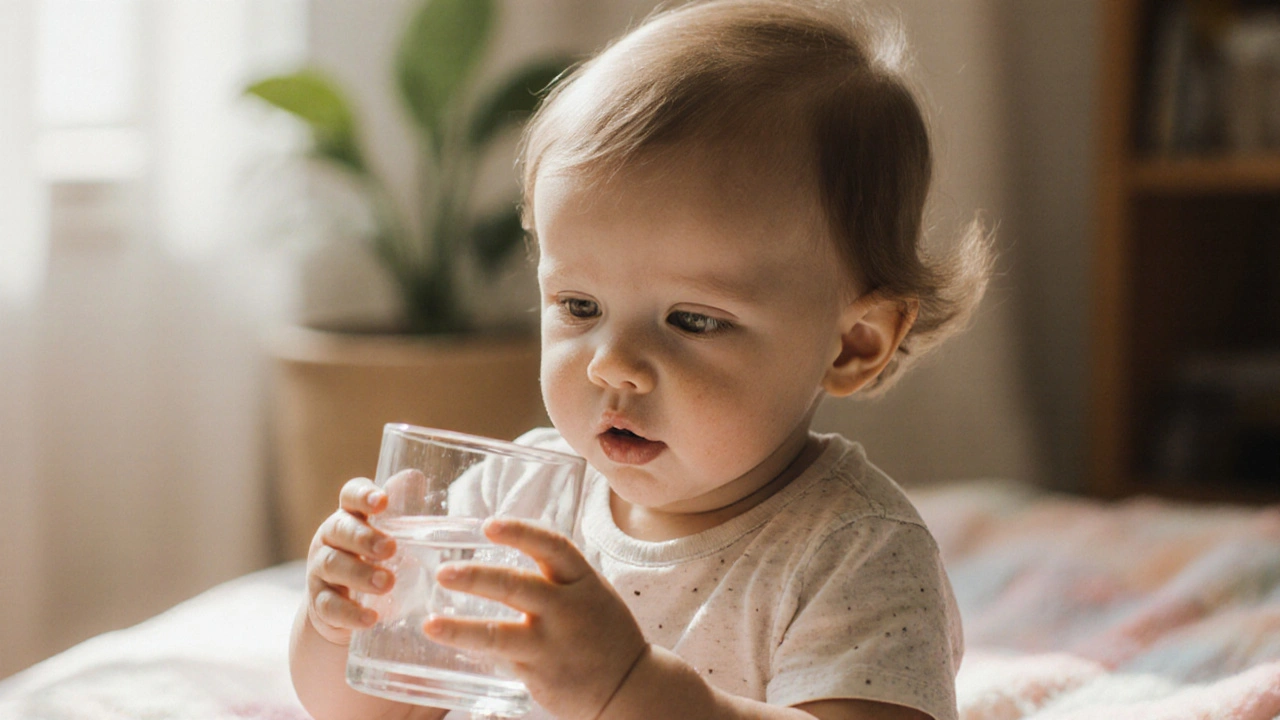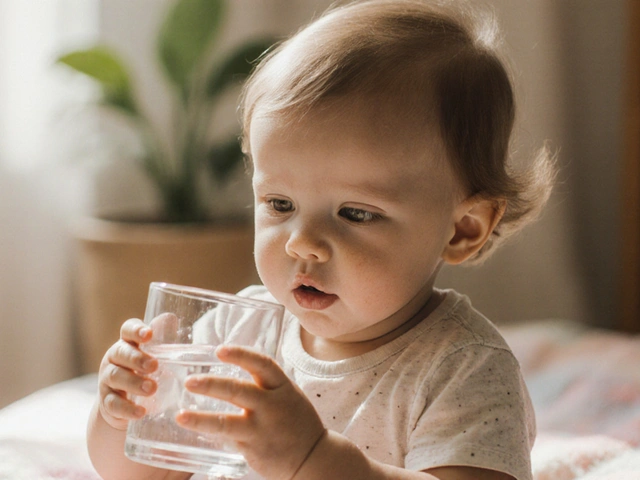ORS Dosage Calculator
Calculate Your ORS Needs
Enter your age group and weight to determine the recommended daily ORS intake for managing dehydration caused by acute diarrhea.
Recommended Daily ORS Intake
Important Notes
- For each loose stool, add 250-500 ml extra fluid for adults.
- Administer ORS in small sips every 5-10 minutes.
- Always use clean, boiled water when making homemade ORS.
- Consult a healthcare provider if symptoms worsen or persist.
Quick Summary
- Acute diarrhea can cause rapid fluid loss, leading to dehydration within hours.
- Watch for dry mouth, reduced urine, sunken eyes, and rapid heartbeat as warning signs.
- Oral rehydration solution (ORS) is the most effective way to replace lost electrolytes.
- Homemade ORS can be made with clean water, sugar, and salt-no fancy products needed.
- Seek medical help if vomiting persists, blood appears in stool, or dehydration symptoms worsen.
What Exactly Is Dehydration and Why Does Acute Diarrhea Trigger It?
When you hear the word dehydration is the condition that occurs when the body loses more water than it takes in, disrupting normal physiological functions, think of it as a fuel shortage for your cells. Acute diarrhea forces your intestines to expel watery stools, often more than 500ml per episode. That rapid fluid loss, combined with the loss of key electrolytes like sodium and potassium, can push you into dehydration in under a day.
In children, the risk is even higher because they have a larger surface‑to‑body‑weight ratio and smaller fluid reserves. A single bout of diarrhea in a toddler can wipe out 10‑15% of body water, a level that can quickly become life‑threatening if not addressed.
How to Spot Dehydration Early
Early detection saves headaches, cramps, and hospital trips. Keep an eye on these signs:
- Dry mouth or sticky tongue.
- Thirst that doesn’t go away after drinking a glass of water.
- Reduced urine output - less than four times a day, or urine that looks dark amber.
- Sunken eyes or a sunken fontanelle in infants.
- Rapid heartbeat (tachycardia) or low blood pressure.
- Feeling dizzy or light‑headed when standing.
These symptoms form a spectrum. Mild cases feel like a sore throat; severe cases can cause confusion or seizures. When in doubt, err on the side of caution and start rehydrating.
How Much Fluid Do You Really Need?
Fluid replacement isn’t a one‑size‑fits‑all. The World Health Organization (WHO) recommends a rehydration plan based on age and weight:
- Infants (0‑12months): 200‑400ml of ORS per kilogram of body weight over 24hours.
- Children (1‑9years): 75‑100ml per kilogram over 24hours.
- Adults: 1.5‑2liters of fluid per day in addition to normal intake, and extra 250‑500ml after each loose stool.
Remember, the goal isn’t just water; it’s to restore the electrolyte balance that water alone can’t fix.

Choosing the Right Rehydration Fluid
Not all drinks are created equal. Below is a quick comparison of the most common options.
| Fluid | Electrolyte Content (mmol/L) | Sugar (g/L) | Best For |
|---|---|---|---|
| Plain Water | 0 | 0 | mild fluid loss only |
| Oral Rehydration Solution (ORS) | Sodium 75, Potassium 20, Chloride 65 | 75 | moderate‑to‑severe diarrhea |
| Sports Drink | Sodium 20, Potassium 5 | 60 | light activity‑related sweat |
| Coconut Water | Sodium 5, Potassium 250 | 55 | natural alternative, moderate loss |
For acute diarrhea, ORS is the gold standard because it supplies the exact mix of sodium, potassium, and glucose the gut needs to absorb water efficiently.
Making Your Own Oral Rehydration Solution
If you run out of commercial ORS, you can whip up a safe version at home. Use clean, boiled (then cooled) water.
- Measure 1liter of water.
- Add 6level teaspoons of sugar (about 30g).
- Add ½level teaspoon of salt (about 2.5g).
- Stir until fully dissolved.
- Give in small sips every 5‑10minutes. Aim for 200‑250ml per hour for adults, less for children.
This recipe mirrors the WHO ORS formulation, delivering roughly 75mmol/L of sodium and 75mmol/L of glucose, which drives water absorption across the intestinal wall.
Make a fresh batch every 24hours-stale solutions can grow bacteria.
When Simple Rehydration Isn’t Enough
Even the best home care has limits. Watch for these red flags:
- Vomiting that prevents you from keeping any fluid down.
- Blood or mucus in stool.
- Fever above 38.5°C (101.3°F) that lasts more than 24hours.
- Signs of severe dehydration: lethargy, sunken fontanelle, rapid breathing, or a drop in urine to less than one diaper change per day for infants.
If any appear, head to urgent care or call your GP. Intravenous (IV) fluids may be required to correct severe electrolyte imbalances quickly.
Practical Tips to Prevent Dehydration During Diarrhea
Prevention is easier than cure. Keep these habits in mind:
- Start rehydrating at the first sign of loose stools-don’t wait for thirst.
- Offer fluids frequently, even if the person says they’re not thirsty.
- Avoid caffeine, alcohol, and high‑sugar sodas; they pull water out of cells.
- Maintain a bland diet-banana, rice, applesauce, toast (the “BRAT” diet) works well while the gut heals.
- Practice good hand hygiene; wash hands with soap for at least 20seconds after using the toilet and before preparing food.
These simple steps cut the risk of dehydration by up to 60% according to recent community health studies.
Frequently Asked Questions
How much ORS should a child drink in a day?
A child aged 1‑9years needs about 75‑100ml of ORS per kilogram of body weight over 24hours. Split the total into small sips every 5‑10minutes.
Can I use sports drinks instead of ORS?
Sports drinks contain less sodium than ORS, so they don’t replace lost electrolytes as effectively. They’re okay for mild fluid loss but not for acute diarrhea.
Is it safe to give milk while someone has diarrhea?
Milk can worsen diarrhea in many people because lactose becomes harder to digest during gut upset. Stick to clear fluids and ORS until stools normalize.
When should I call a doctor for dehydration?
Call immediately if the person can’t keep any fluid down, shows signs of severe dehydration (sunken eyes, rapid heartbeat, lethargy), or has blood in the stool.
What’s the difference between dehydration and water intoxication?
Dehydration is a deficit of water and electrolytes, while water intoxication (hyponatremia) occurs when you drink too much water without enough salts, diluting blood sodium levels.







Jack Marsh
October 4, 2025 AT 18:50While the ORS dosage calculator presents a convenient tool, the underlying assumptions regarding fluid requirements merit scrutiny. The recommendation of 250‑500 ml per loose stool appears arbitrary, lacking reference to peer‑reviewed pharmacokinetic data. Moreover, the emphasis on “small sips every 5‑10 minutes” does not account for variability in gastric emptying rates among different age groups. A more rigorous approach would cite WHO guidelines and delineate the margin of error inherent in self‑administered solutions. In practice, patients often miscalculate weight inputs, thereby compromising dosage accuracy. Consequently, reliance on a simplistic web interface may engender a false sense of security. It would be prudent to complement the calculator with a brief educational module on proper measurement techniques. Additionally, integrating a validation step for weight entry could mitigate user error. Lastly, the disclaimer urging consultation with a healthcare provider should be prominently displayed, not relegated to a footnote.
Terry Lim
October 9, 2025 AT 11:53This advice oversimplifies a complex clinical scenario; patients need professional assessment, not a generic calculator.
Cayla Orahood
October 15, 2025 AT 06:46What the mainstream health sites won’t tell you is that the “clean, boiled water” mantra is a covert push from big‑water corporations to keep us buying bottled supplies. The ORS formula itself was originally devised by agencies collaborating with pharmaceutical giants, ensuring a lucrative market for pre‑packaged mixes while dissuading home‑brew alternatives. If you truly want to stay hydrated during an acute bout of diarrhea, you must scrutinize every ingredient, question the source of the salts, and consider the hidden electrolytes that are deliberately omitted. Trusting a glossy web widget without interrogating its sponsors is tantamount to surrendering your health autonomy.
McKenna Baldock
October 21, 2025 AT 01:40Staying properly hydrated during an episode of acute diarrhea is not merely a matter of ingesting fluids; it reflects a broader principle of maintaining homeostatic balance within the body. The oral rehydration solution (ORS) functions as a conduit for restoring electrolyte equilibrium, a process that mirrors the philosophical concept of restoring harmony after disruption. In practical terms, each lost stool represents a quantifiable deficit of sodium, potassium, and water, and the recommended addition of 250–500 ml per episode aligns with the physiological need to replace these losses gradually. It is essential, however, to appreciate that the rate of replacement must respect the gastrointestinal absorption capacity; excessively rapid intake can precipitate vomiting, negating the intended benefit. Consequently, the guideline of sipping small amounts every five to ten minutes is grounded in both clinical evidence and an understanding of digestive kinetics. Moreover, the preparation of ORS at home demands the use of boiled, cooled water, a precaution that eliminates pathogenic microbes while preserving the solution’s osmolarity. When measuring the requisite salts-typically glucose, sodium chloride, potassium chloride, and trisodium citrate-precision is paramount, as even slight deviations can alter the solution’s tonicity. This underscores the value of accurate scales or calibrated measuring spoons, tools that complement the calculator’s digital estimates.
From a collaborative perspective, patients should be encouraged to discuss their hydration plan with caregivers or healthcare providers, fostering a shared responsibility for health outcomes. In communities where access to commercial ORS packets is limited, disseminating knowledge about homemade formulations can empower individuals to manage dehydration autonomously. Yet, it is equally important to recognize the limits of self‑care; persistent vomiting, blood in stool, or signs of severe dehydration warrant immediate medical attention. The calculator’s “important notes” section wisely includes a reminder to consult professionals if symptoms worsen, reinforcing the principle that technology augments, rather than replaces, clinical judgment.
Finally, the psychological comfort derived from taking proactive steps should not be underestimated. Engaging in the ritual of preparing and consuming ORS can provide a sense of control amidst the uncertainty of illness, thereby supporting the patient’s overall well‑being. By integrating precise fluid replacement, collaborative decision‑making, and mindful observation of symptom progression, we can address dehydration in a manner that is both scientifically sound and humanistically compassionate.
Roger Wing
October 26, 2025 AT 20:33Sure the calculator looks nice but who vetted the algorithm its probably just a corporate ploy to sell more packaged ORS no real science behind it
Mike Brindisi
November 1, 2025 AT 15:26Actually the WHO did publish the formula back in the 70s and the numbers are based on controlled trials you can find them in the original technical report no need to chase conspiracies
Steven Waller
November 7, 2025 AT 10:20When dealing with dehydration, remember that staying hydrated is a communal responsibility; sharing knowledge about proper ORS preparation can help neighbors and families alike, so feel free to spread the information responsibly.
Puspendra Dubey
November 13, 2025 AT 05:13OMG i cant even 😱 when my gut goes crazy i just mix the salt n sugar like a chef lol but u gotta make sure u use clean water or else u get sicker 😂
kevin muhekyi
November 19, 2025 AT 00:06Sounds like a solid quick fix, just remember to keep the ratio balanced and avoid too much sugar.
Teknolgy .com
November 24, 2025 AT 19:00Not impressed 😒 this whole ORS thing feels like a recycled blog post with no fresh insight, just copy‑paste from old guidelines.
lalitha vadlamani
November 30, 2025 AT 13:53While some may dismiss the content as mundane, the underlying principles of electrolyte balance are timeless and merit serious consideration, lest we neglect foundational medical wisdom.